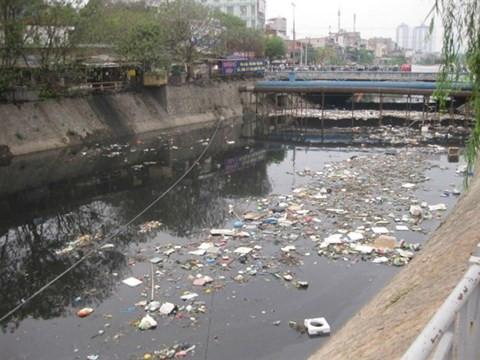Experts warn of environmental incidents as only 10% of urban waste water treated
Untreated or improperly treated waste water from treatment plants may lead to eutrophication, which causes algae blooms in rivers and lakes, leading to pollution, and serious environmental incidents.
 |
According to the Vietnam Water Supply and Drainage Association, by the end of 2016, Vietnam treated only 10 percent of total urban waste water.
There are only 35 operating concentrated water treatment systems in provinces and cities with total designed capacity of 850,000 cubic meters per day.Of the 35 waste water treatment plants, there are only five plants using biological treatment technology, 15 plants with second-level biological treatment technology, and eight plants with second-level biological treatment technology in association with nitrogen treatment.
Meanwhile, only seven plants can treat waste water with bio-technology with nitrogen and phosphorus treatment.
This means that most of the plants can only remove organic matter and pathogenic microorganisms, while they don’t pay attention to the treatment of nitrogen and phosphorus in waste water. The existence of nitrogen and phosphorus lead to eutrophication.
In many cases, waste water treatment plants are designed and operated in a way that does not fit the characteristics of waste water, thus leading to reduced environmental protection.
There are about 5,000 craft villages across the country with industrial production workshops, but most of them don’t have stations to collect and treat waste water.
With a serious lack of technical infrastructure to treat waste water and sludge, the excess of nutrients in the form of nitrogen and phosphorus compounds causes eutrophication in rivers, lakes and reservoirs.
According to Tran Thi Viet Nga from the Hanoi University of Civil Engineering, waste water contains many pollutants and toxins which harm the environment and human health.
Ammonia, nitrite (NO2), nitrate (NO3) in strong concentration in rivers and lakes is the cause of oxygen depletion in water sources and the algae blooms phenomenon.
“Nitrogen and phosphorus not only cause eutrophication in rivers and lakes, but also can cause pre-cancerous substances and respiratory failure in children,” Nga said.
According to Nguyen Phuong Quy, director of SFC Vietnam, the characteristic of urban waste water in Vietnam is the low organic matter and high nitrogen and phosphorus concentration, which makes it difficult to treat the waste. The characteristic is attributed to the bad collection system, Vietnamese habits used in food processing and use of chemicals with high phosphorus content.
Quy said that the treatment of nitrogen and phosphorus is a requirement mentioned in all national waste water treatment standards, but many investors in treatment plants ignore the requirement.

